Wolf spiders and grass spiders are often confused. Similar in appearance, these spiders are still very distinct in lifestyle.
The main visual difference between Wolf spiders and Grass spiders is in the black lines on the abdomen. These are thicker and richer in color on Wolf spiders. Grass spiders have pale thinner colors by comparison.
The Wolf spider also doesn’t weave a web, unlike the grass spider that weaves funnel webs. Grass spiders use these webs for survival while Wolf spiders solely rely on hunting abilities for survival.
These spiders also differ in size, habitat, and mating ritual. However, both species are found in North America frequently. They are often confused given their physical similarities.
Table of Contents
What Are Wolf Spiders?
Wolf spiders have a gray-brown color with a hairy body. They feature distinct black parallel lines on their bodies. They range in size from 10mm to 35mm in adulthood. These fury spiders can also be identified by their eyes.
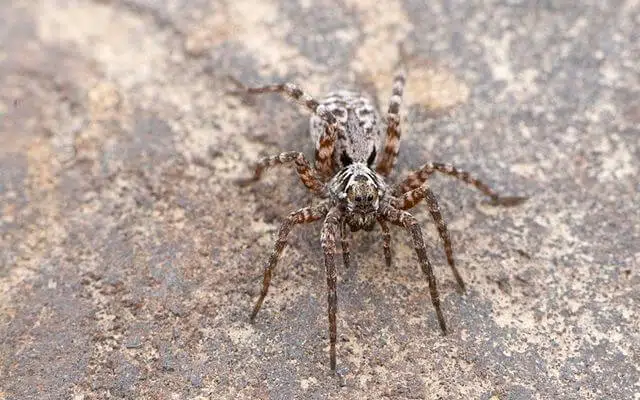
Wolf spiders have 8 eyes. These are grouped in rows and they are different in size. The bottom row has 4 small eyes. The middle row has 2 large centered eyes. The top row has 2 smaller eyes wider apart than the eyes of the middle row.
If you still can’t positively identify a Wolf spider you can inspect its legs. Wolf spiders have 3 tarsal claws or 3 final segments of the legs. These are distinctly shaped like claws.
The Wolf spider is often confused with small tarantulas and the Brown Recluse. Wolf spiders are smaller than tarantulas and they have different fangs. Wolf spiders don’t have a violin-shaped mark on their back as the Brown Recluse. But the easiest way to distinguish the Wolf spider from the Brown Recluse is the length of the legs. Wolf spider’s legs are shorter.
The habitat of Wolf spiders is also wide open compared to other web-making spiders. Wolf spiders are found in grass, on arid terrains, on crops, mountains, but especially in forests where they can hunt for a wide selection of insects.
What Are Grass Spiders?
Grass spiders get their name from their living environment. These spiders live on the ground where they are hard to spot in the grass. The species has been first named in 1869, being one of the oldest spider species to be described.
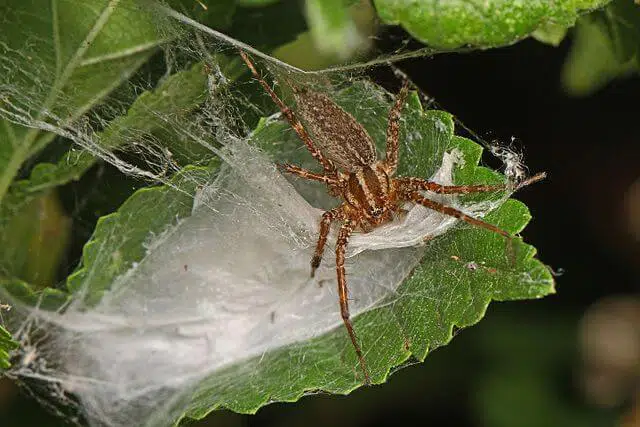
These spiders weave sheet weaves with a hiding funnel. This funnel is always something that differentiates them from plain weave spider webs.
Grass spider’s survival depends on the success of the spider weave. The silk of this weave is not as sticky as the silk of other spider species. However, Grass spiders are fast runners which means they rarely miss the opportunity to attack a trapped insect.
The spider can be recognized by faded black lines on the abdomen. But it can also be a species easily identified and distinguished from other spiders by its eyes. Grass spiders have 8 eyes. These eyes are placed on three rows. 2 eyes are on the top, 4 eyes are present in the middle row, while 2 eyes make up the bottom row.
Grass spiders don’t wander too much in their lives. They prefer grassy terrain and they weave webs at ground level. These spiders use grass to anchor their webs. It means they eat a lot of insects that live at ground level as well.
Why Are Wolf Spiders Often Confused With Grass Spiders?
Wolf spiders are sometimes confused with Grass spiders given their similarly hairy appearance with two lines on the abdomen. These spiders are different, however. They are not spiders of the same family which means their resemblance doesn’t have an evolutionary role.
While different spiders, both Wolf and Grass spiders have their similarities. These similarities are part of the general confusion that sometimes stops people from correctly identifying the two species.
Appearance
Both these spiders have yellow, brown, and gray appearances. These are hairy spiders with 2 black lines running along with their bodies.
The similar appearance of these spiders is well adapted to their living environment. The lighter color of the Grass spider is adapted to ground level living on grass and shrubs.
The pale brown color of the Wolf spider characterizes the hunting nature that keeps it moving on the ground and up on trees and buildings.
Habitat
Grasslands and woodlands are ideal habitats for the Wolf spider and grass spiders. Most Wolf spiders are present in areas where Grass spiders live. But some Grass spiders aren’t present in areas where Wolf spiders live such as deserts.
Location
Both Wolf spiders and Grass spiders live in every US state. Their presence around the world is different. However, their North American presence is similar as these have been spotted in all states.
Perfect locations for these spiders include woodlands and grasslands. They abound in nature, especially close to woodlands.
Diet
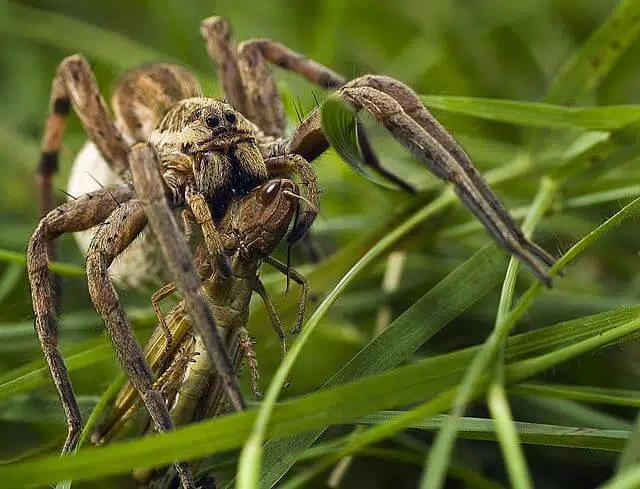
Both spiders eat small and very small insects. These are typically insects found at the grass level. The most common food for these spiders includes grasshoppers, moths, crickets, and aphids.
Further Reading:
Wolf Spider vs Grass Spider: 11 Major Differences
Wolf spiders and Grass spiders are radically different once compared in other areas such as habitat and not by appearance. These spiders are found in every US state but they behave differently.
Here are the main differences between Wolf spiders and Grass spiders.
| Wolf Spider | Grass Spider | |
| Lifespan | 1 – 2 years. | less than 1 year. |
| Size | 10 – 35 mn. | 10 – 20 mn. |
| Color & Markings | Brown, yellow, gray. Black lines. | Lighter brown, yellow, gray. Light marking. |
| Spinnerets | Short. | Long. |
| Eyes | Good eyesight. 4 eyes in the bottom row. 2 eyes in the middle row. 2 eyes in the top row. | Poor eyesight. 2 eyes in the bottom row. 4 eyes in the middle row. 2 eyes in the top row. |
| Behaviors | Ambush the prey. | Spin funnel-web to capture the prey. |
| Habitat | Woods, deserts, garden, house. | Meadows, garden, open areas. |
| Web | Don’t use web. | Use the complex web. |
| Egg Sacs & Spiderlings | Carry egg sacs. Care for spiderlings after hatching. | Carry egg sacs. Females die before hatching. |
| Mating Ritual | Males use vibration to attract females. Females can eat males after mating. | Males sway their abdomens to attract females. Females can eat males after mating. |
| Bite | Weak venom. Can cause a skin reaction. | Weak venom. |
1. Lifespan
Wolf spiders live at least one year. The male Wolf spider lives 1 year while the female Wolf spider lives at least 2 years. The lifespan of Wolf spiders is similar to the lifespan of other spiders.
Grass spiders live shorter lives. Female Grass spiders live up to a year while male Grass spiders have a shorter lifespan. Some male Grass spiders are killed during the mating process by the female essentially securing the female’s longevity over the male spider.
2. Size
Wolf spiders are larger than Grass spiders, but not by a lot. A large Wolf spider can grow to a length of 35mm while a large Grass spider can grow to a length of 20mm. Both species are characterized by high variation in size from the male to the female of the species.
Female Wolf spiders and female Grass spiders are larger than male Wolf spiders and male Grass spiders. A female Wolf spider grows to maximum body size of 35mm while males of the species can’t reach this size. The same applies to Grass spiders.
Female Grass spiders reach a size of up to 20mm. Even the largest male Grass spiders only reach a size of 18mm.
3. Color and markings
Most Wolf spiders are brown, yellow, and gray. They have black lines which are considered color-saturated compared to the faded black lines that similarly run on the abdomen of the Grass spider.
The grass spider is lighter in color, but still generally brown, yellow, and gray with black lines. This spider also has light markings on its hairy body and its hairy legs compared to darker markings on Wolf spiders.
4. Spinnerets
A spinneret is an organ that spins silk for a spider. Grass spider spinnerets can be seen on the spider without turning it over. They have 2 hind spinnerets visible in a normal position.
The Wolf spider has 2 types of spinnerets uses. First, they use it to spin silk. But spinnerets are also used by Wolf spiders to carry the egg sack.
The egg sack is attached to the spinnerets for some Wolf spiders while others carry their egg sacks using pedipalps.
5. Eyes
Both spiders have 8 eyes but their arrangement is different.
Wolf spiders have excellent vision. It’s believed this great vision is a solid attribute of a hunting spider such as the Wolf spider.
There are 8 eyes the spider uses to sense its proximity and to see its prey. These spiders have a bottom row of 4 eyes, a middle area with 2 large eyes, and a top row with 2 smaller eyes.

Grass spiders also have 8 eyes but with different placements. The eyes of these spiders are also split into 3 rows. The bottom row has 2 large eyes which are the widest apart. The middle row has 4 smaller eyes that are closer together. The top row has 2 smaller eyes.
6. Behavior
The behavior of these spiders characterizes their species. Wolf spiders don’t spin webs while Grass spiders spin complex webs in the grass.
Wolf spiders look for insects and invertebrates such as grasshoppers without weaving a spider web. They move around frequently actively looking for prey. The behavior of these spiders is similar to the behavior of real wolves that hunt around.
Grass spiders spin a funnel weave. This circular weave is their only method of hunting. Unlike Wolf spiders, Grass spiders are more stationary. They don’t move around as much (except the mating period). They prefer to weave funnel weaves in the grass where they away insects to fall into a trap.
7. Habitat
The habitat of these spiders sometimes intersects. But it’s quite different most of the time. Wolf spiders are seen all across the country. They are seen in woods, deserts, next to water sources, gardens, and even in the house.
Grass spiders are mostly seen in the grass or small bushes at ground level. They prefer to live on the ground in meadows, gardens, and open areas.
The habitat of Grass spiders is a lot more prohibitive to movement compared to the habitat of Wolf spiders which love to move around from one area to another.
8. Web
The Wolf spider doesn’t spin a web. It doesn’t need a web as it uses hunting for prey. These spiders can still make silk as seen when carrying the egg sack with the spiderlings.
However, the Grass spider is different. It creates one of the most spectacular funnels weaves seen in the spider world. Perfectly circular it has a wide opening and a narrower inner section which is believed to be a tactic to catch more prey.
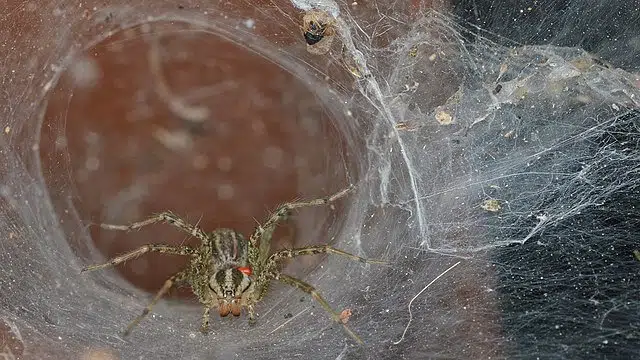
9. Egg sacs and spiderlings
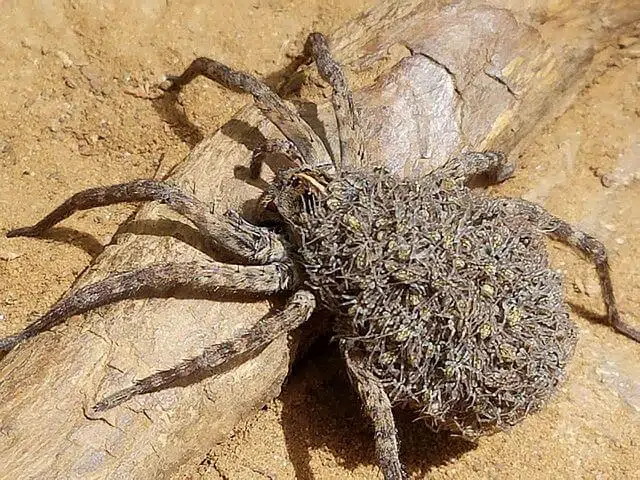
Egg sacks are carried by both Wolf spiders and Grass spiders. The female Wolf spider carries this sack for a few weeks before hatching.
The Grass spider female carries the spiderlings sack. However, the female Grass spider normally dies before the eggs hatch.
10. Mating ritual
Mating rituals are similar to these species but still quite different in certain ways. For example, males from both species have to court females. But the male Wolf spider is believed to use vibrations to impress the female. These are similar to singing in the spider world.
The unsuccessful attempt to court a female can trigger a cannibalistic reaction in the female who can eat the male Wolf spider.
Male Grass spiders often attempt to impress the female as well. They use a spermatophore to transfer sperm to the female.
This happens twice per year. Females can often eat males, especially if the mating attempt is unsuccessful. Some studies show that a female can mate with up to 3 males per season. However, it’s only the first male that has the highest risk of getting eaten by the female.
11. Bite
The bites of these 2 spiders aren’t dangerous to humans. They can happen but they are generally not followed by an adverse reaction.
Wolf spiders have long fangs that can penetrate human skin. However, their venom isn’t poisonous to humans. It’s only poisonous for its small prey that is paralyzed by the venom.
Grass spiders have short fangs that can’t penetrate or properly penetrate the skin even when bitten. Allergic reactions to a Grass spider bite are rare. Adverse reactions to a Wolf spider bite are generally mild pain in the area of the bite with possible itching or skin redness.
Which is More Venomous?
Both spiders have venom. But this venom isn’t dangerous to humans in such small quantities.
Furthermore, Grass spiders don’t have long fans to properly penetrate human skin.
Wolf spiders have long fangs and weaker venom but they can feel a bit more painful when biting a human given they penetrate the skin better.
Still, neither of these species is dangerous to humans in case of a bite.
How to Prevent Them Getting Into Your House?
You can prevent spiders from getting into your house by keeping your garden clean and the lawn clear at all times.
Here are the most sensitive measures that prevent Wolf and Grass spiders from getting into your house.
Mow lawns frequently
Mowing the lawn is one of the proven methods of keeping Wolf spiders and especially Grass spiders away. You can destroy the wave of a Grass spider during the mowing process which will prompt these spiders to leave.
Avoid leaving pet food out
Pet food and pet food remain to attract spiders. You should eliminate all pet food remains from around your house if you don’t want spiders to keep returning to find more.
Remove food remains from around the house
Insects enter your home when you have dirty dishes and food remains. Wolf spiders are attracted to both insects and food remains. The cleaner the kitchen is the lower the chances of seeing these spiders return.
Eliminate vegetation piles
High vegetation, uncut lawns, and piles of leaves are ideal habitats for Wolf and Grass spiders. Plenty of insects are found in dense vegetation. The more you strive for a clean garden and area around the house the lower the risks for spiders to actively seek to live and hunt in these habitats.
Trim bushes
Trimming vegetation such as low bushes is crucial to keeping Grass spiders away. Low bushes are ideal breeding grounds for Grass spiders who see these as good alternatives to tall grass. Constantly trimming vegetation around the house is one of the proven techniques to keep spiders and pests away.
Summary
Wolf spiders and Grass spiders are similar but distinct at the same time. They might both come with black lines on their body and with a similar brown nuanced color. But one species is interested in hunting while another species is interested in weaving spider webs.
Wolf spiders like to hunt and cover large areas to find food. Grass spiders like to stay put and weave funnel webs which inevitably catch prey at grass level. Both species live further out in nature but they are seen around US homes as well since they’re present in each state.
These spiders live a year or two but their short lives are characterized by distinct behavior.
Wolf spiders are known for their complex mating rituals. Grass spiders are known for their cannibalistic mating rituals.
Both sets of spiders can lay hundreds of eggs at a time either once or twice per year. This makes these some of the most prolific spiders in the country.
Chances are high to see both these spiders. Wolf spiders and grass spiders can be seen in gardens the easiest.
Grass spiders only emerge to eat their prey once it gets tangled in the funnel web, a unique structure that looks like a cave.
Further Reading: